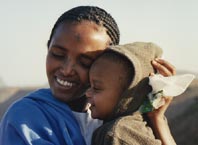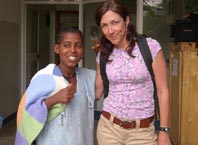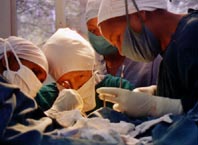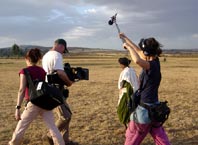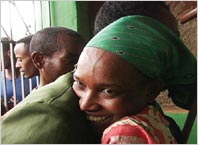The
Producer's Story:
Capturing
Hard Truths in Ethiopia
by Mary Olive Smith
To
tell the story of women hiding in shame in a remote corner of Africa posed
inherent problems in the making of "A Walk to Beautiful." How could
we show their loneliness and isolation while at the same time time entering
their intimate space? How would we follow a woman smelling of urine on a long bus
ride to Addis Ababa, Ethiopia's capital, and remain true to the
experience she and so many like her have endured? At the end of a day of
shooting, how should we respond to 10 people suffering from various illnesses
lined up outside the family compound hoping to get help from
us—foreigners with cars and money?
Getting
at the truth is our goal as documentarians, of course. But by virtue of our
presence—crew, camera, microphone—the truth becomes invariably
distorted. For decades, nonfiction filmmakers have confronted this conundrum,
and our film shoot in Ethiopia was no exception. Could we capture the harsh
reality these voiceless women experience?
A
hidden agony
I
first visited the Addis Ababa Fistula Hospital in the spring of 2004. The idea
for a film about the hospital and women with obstetric fistula came from a New
York Times op-ed column by
Nicholas Kristof entitled "Alone and Ashamed" (May 16, 2003). A
friend of Steven Engel, head of Engel Entertainment, where I've worked
for 12 years, brought the piece to Steve and said, "What are you going to
do about this?"
Steve
took the question to heart, and after discussing it with our development team,
he decided to embark on the company's first feature-length documentary.
We, his staff, were with him from the start. We are mostly women, and learning
of the secret and excruciating suffering that millions of women experience, we
felt compelled to begin this journey.
Full Circle
In
many ways I personally had been preparing and hoping to make a film like this
my whole career. Before joining Steve's company in 1996, I spent five
years working in public radio on an interview program that focused largely on
international issues. I then attended the School of International & Public
Affairs at Columbia University, where, through a media concentration, I picked
up a camera for the first time. I went on to make a documentary about a
quadriplegic boy who learned to stand again while finishing a large painting in
a children's art-therapy program at Harlem Hospital.
I
was hooked. After finishing my master's, I received a fellowship to spend
five months in West Africa. My love for Africa began then. Camera in hand, I
explored human rights abuses associated with a resistance movement in the
tropical zone of Senegal. The years that followed at Engel Entertainment (at
the time called Engel Brothers Media) took me to South Africa and Zimbabwe as
well as many parts of Asia and Latin America to work on documentaries for
television. The subjects I covered ranged from ancient mummies to cutting-edge
cures for breast cancer.
But
when Steve offered me the opportunity to direct a feature-length doc on women
suffering from obstetric fistula, I jumped at it. I felt I would finally be
able to bring my career and personal interests full circle.
Beauty
and suffering
My
weeklong scout in 2004 at the Fistula Hospital ended with an elegant dinner and
tea at the home of Dr. Catherine Hamlin. Her small house, where she has lived
for over 30 years, sat tucked into the hillside below the hospital she and her
husband built. (Dr. Reginald Hamlin died in 1993.) The house is as naturally
ensconced in the landscape as the flowers that adorn the hospital grounds. With
hopes that a feature film with an international audience would help her build
an endowment to keep the hospital running long after her own death, Dr. Hamlin
graciously granted us approval to make the film.
For
the next nine months I researched obstetric fistula, imagined the stories,
drafted a hypothetical narrative, and, most importantly, assembled a talented
crew. Having been stunned over the years by Africa's beauty as much as by
its suffering, I was determined not to show one without the other.
Jerry
Risius, a talented cinematographer, accompanied my crew into Ethiopia's
rural Amhara region (historically known as Gojam). The hilly landscape west of
the Blue Nile Gorge was stunning. Working with a high-end HD camera and
assisted by our coproducer Allison Shigo, Jerry's job for one week was to
film the beauty and village life of the country. He rose every morning at 5
a.m. to shoot a time-lapse sunrise, and he found the perfect spot every evening
to capture the sunset. He and Allison filmed women getting water from a well,
washing clothes in the river, carrying inconceivably heavy jugs on their backs.
A
long search
Meanwhile,
I went out with a team of two other people, a smart and gentle-voiced
interpreter from Addis named Bethelhem Belaney and our staff associate producer
Aysin Karaduman, who recorded sound. Aysin's vitality on our long hikes
kept the crew energized and the local shepherd boys entertained.
For
a week we interviewed women off the main road of a town called Finote Selam,
shacking up at night in a flea-ridden truck stop called the Extreme Hotel. We
spoke to and interviewed many sick women, but none with the most common symptom
of obstetric fistula—incessant leaking of urine.
Each
evening I called my counterpart, director Amy Bucher, at the Fistula
Hospital. She had begun interviewing women there and, among the 120 patients,
she had found two stunning young women—Wubete and Almaz—who would
bring the humor and hard-earned joy that gave the film its ending.
Amy's
crew consisted of another staff associate producer named Jess Beck and
cinematographer Tony Hardmon. Jess and Amy bonded like sisters with the girls
and women they spent time with at the hospital, and Tony's calm presence
and patient eye made him welcome on the ward. To act as their interpreter, we
hired a dazzling Ethiopian woman named Makda Teklemichael. (A year later, we
had the good fortune of hiring Makda at Engel Entetainment when she moved to
the United States to be with her husband.)
Within
just a few days, Amy was able to lock in her characters, but so far I had come
up short. Would we have a film?
Success
at last
After
extending our trip, our luck finally changed. In the local marketplace a boy
told us of "a woman who is leaking" that he knew of in his village.
At first he resisted taking us to her, afraid he would get in trouble for
exposing her shame. But after much persuasion he led us on our first long walk
to a village, where we met Zewde*. Bearing an infectious smile, Zewde was a
38-year-old woman who had suffered through obstructed labor in the birth of her
sixth child.
Our
luck held over the coming days. Our encounter with Ayehu occurred exactly as it
appears in the film. We were led to her by Fikre, the young woman in a white
turban whom we film walking briskly toward Ayehu's village. After
spending 10 years with fistula, Fikre had been cured in Addis and wanted the
same for her friend. Lastly, just two days before we left the country, a
concerned family brought Yenenesh to us at our hotel.
We
tried to be as true to the women's experiences as possible, using a
vérité or "fly-on-the-wall" approach to filming,
combined with conversations with the women. The interviews with Dr. Hamlin and
her fellow doctors provided the context and took the place of a narrator.
Later, our editor Andrew Ford worked the material elegantly—holding the
shots, never using dissolves. Without Andrew's talent and David
Schommer's haunting soundtrack, the stories would not have held together
as effectively. The music combined David's original composition and his
collaborative work with our featured cellist, Dave Eggar, with the music of
traditional musicians that we recorded in Ethiopia and the a cappella voices of
the nurses at the hospital.
Becoming
whole
Though
I had traveled to more than 30 countries, I was not prepared for the mix of
emotions I felt during the filming in Gojam. I ached from the grief of the
women we met even as I felt enormously privileged to be allowed a glimpse into
their private hell. I was struck by the rural beauty even as I stood in awe of
the dignity of the people who survived there on a subsistence level.
Each
of these women was grateful for a chance to tell her story. After years of
loneliness, they were desperate to be heard. Ashamed, in some cases
near-suicidal, they needed compassion as much as a chance to be cured. The
women had placed a great amount of trust in us, and I felt a huge
responsibility for their safety. You cannot know my relief when they finally walked through the gates of the
Fistula Hospital, into the caring and skilled hands of Dr. Hamlin and her
staff.
Dr.
Hamlin's hospital is truly an oasis, a flower-filled haven where social
stigma melts away, where smiles appear on drawn faces for the first time in
years, and where women eagerly learn to read or knit. We watched as some women
sat pensively on the steps above the garden and others giggled on the cool
grass, each one becoming whole again in her own way and her own time.
I
realized that the "walk to beautiful" that these women hoped to
make was not just to the hospital for a cure but for social acceptance and the ability to be part of a
community again back home. If as filmmakers we succeeded in revealing this
simple truth in a dignified way, then we fulfilled our purpose.

